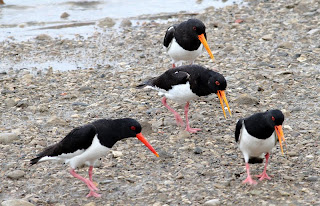As I drove through Pilling village I bore down upon what from a distance away I took to be a corvid in the middle of the road. Only too late as I got up to the bird did I realise it was a Sparrowhawk with prey, and as I slammed on the anchors and reached for my camera on the passenger seat, the bird flew off carrying what was left of a small passerine. I really need a couple of pictures of a Sparrowhawk not in the hand, but they are not easy to get. One shot through the garden last night and hid in a neighbour's sycamore. Then later in the day I disturbed another when I went to ring some Swallows but it shot out of sight very quickly. Boy those Sparrowhawks don’t sit about in the open much.
It rained and gusted all the time I was at Conder Green and limited my brief birding. I got a good count of Common Sandpiper, with a minimum of 18 birds but took a shot of one I noticed with two colour rings, yellow and red, and a standard BTO metal ring on the other leg. Later I reported it online through “Euring”. But I don’t think I will win any prizes with the photograph taken in a downpour.

Other waders in the creek comprised a Little Egret and one each of Spotted Redshank, Greenshank, with 130 Redshank, 2 Bar-tailed Godwit, 1 Black-tailed Godwit and 7 Dunlin, with red and black being the dominant colours of these almost full adult plumage birds.

The sleek, black Oystercatchers with their thick carrot bills went through again with their noisy, elaborate, displays and territorial disputes around the pool, so I snatched a few pictures before the rains came again and I headed home.



Later I checked out a Swallow nest and ringed 5 young but all in all my Swallows aren’t having a good year, and whilst a brood of five I ringed about 10 days ago are ready to fly, they are minus one that fell victim to the Border Terriers in the dog pen below the nest.

























































.jpg)












